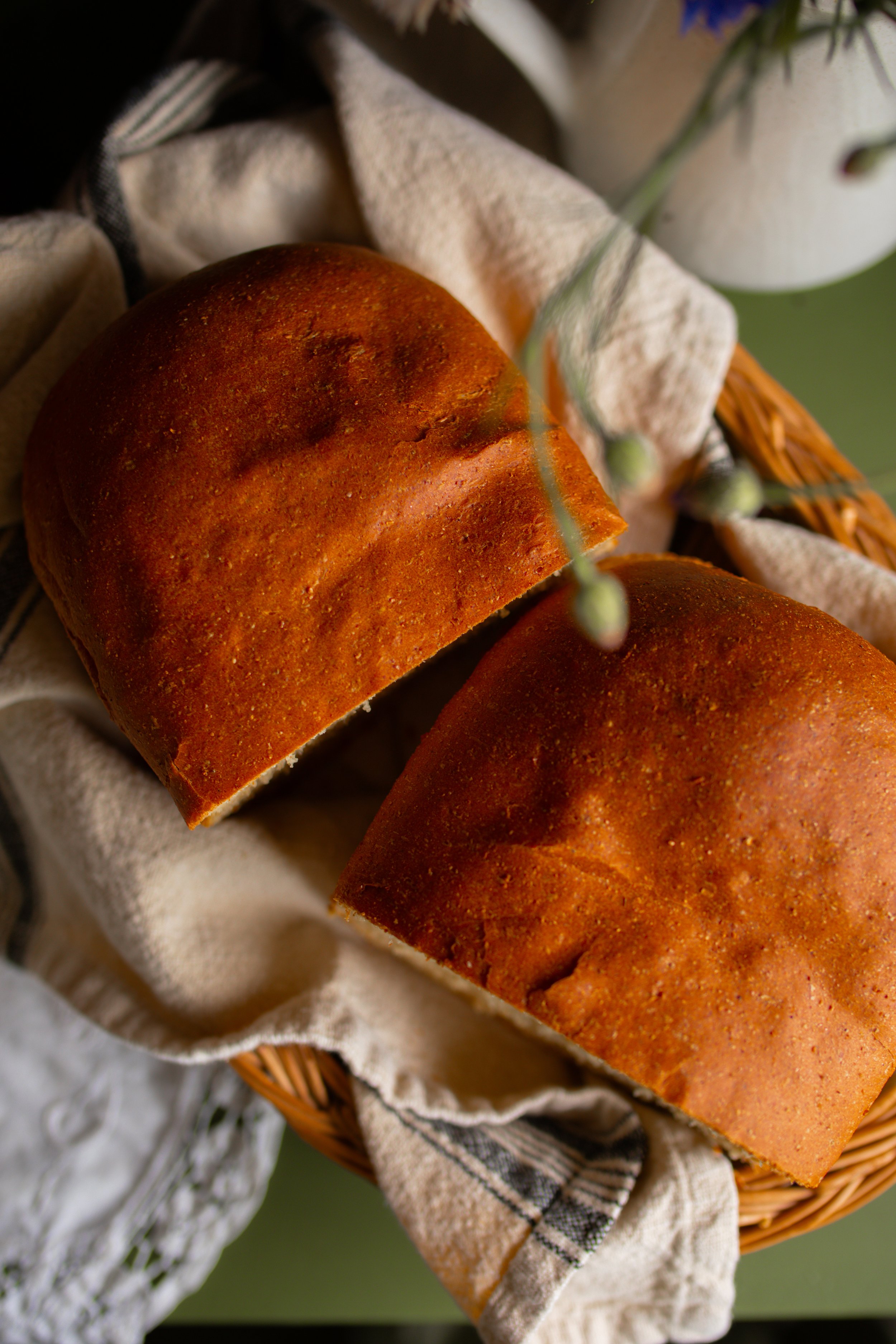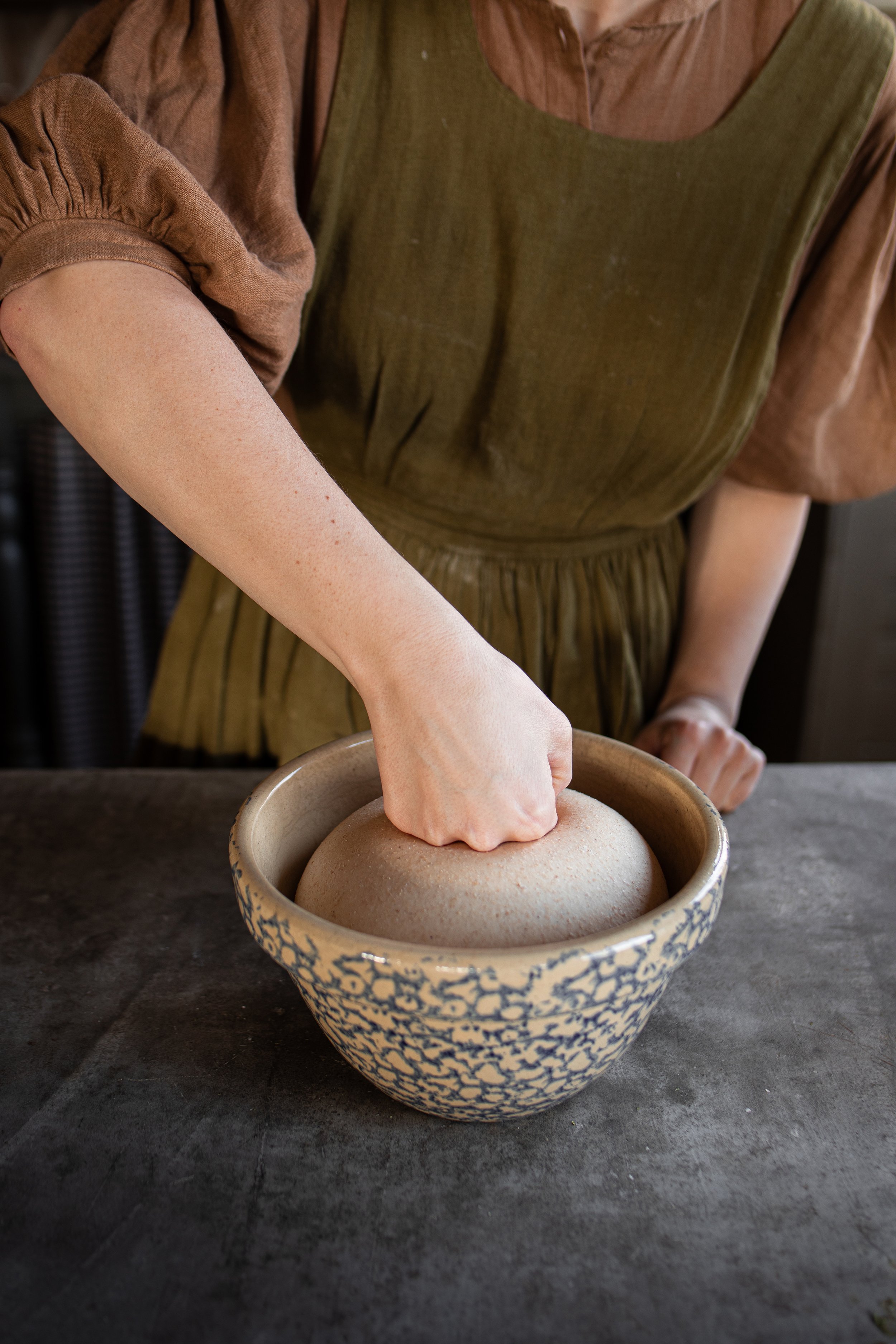Cottage Whole Wheat Sandwich Bread
This post may contain affiliate links, please see our privacy policy for more information.
There’s nothing more tasty than homemade whole wheat bread! It’s nutty and sweet aroma fills your entire kitchen with scents reminiscent of a beautiful country cottage. This whole wheat sandwich bread recipe utilizes the amazing health benefits and flavor of whole grain wheat flour and is naturally sweetened with honey. In this recipe learn how to make homemade whole wheat bread with shaping techniques as well as how to mill your own spelt flour at home. It’s the perfect cottage loaf bread recipe!
what is sandwich bread?
Sandwich bread, also referred to as loaf bread, pan bread, or a sandwich loaf, is a style of bread making that is baked in a rectangular pan specifically for sandwich making. This style of bread is the most commonly purchased bread in the United States, and it often will fill an entire aisle of a grocery store.
Did you know that it is incredibly easy to make sandwich bread at home? While it may not feasible to swap out your weekly bread with homemade all of the time, it can be quite fulfilling to bake up a few loaves at home every now and then! To make your own sandwich bread at home, the only thing you need is a standard 9 x 5-inch (23 x 13-cm) loaf pan.
gathering ingredients to make whole wheat sandwich bread:
To make your own whole wheat sandwich bread, you will need to gather a few key ingredients. Whether you want to try grinding your own grains at home, or purchase whole wheat flour, you can easily find the ingredients you need to make this delicious cottage loaf. You can make this whole wheat bread recipe in about 3 hours!
Whole Wheat Flour. For this recipe, I ground my own wheat at home in my flour mill. Any whole wheat flour will work for this recipe, with the exception of whole wheat pastry flour.
All-Purpose Flour. To prevent your loaf from becoming incredibly dense, all-purpose flour is also worked into the dough to help give your bread a soft and tender crumb.
Active Dry Yeast. Active dry yeast is what helps your bread to grow! I would not suggest substituting this for instant or fresh yeast.
Honey. To help sweeten your bread, I used honey. You can substitute granulated or brown sugar for the honey 1:1.
Butter. I prefer to use salted butter in my recipes, but you can use unsalted butter if that is what you prefer!
Salt.
how to work with whole wheat flour:
Whole wheat is a wonderful healthful grain that can be used as an all-purpose flour alternative. However, working with whole grains is very different from working with a bag of store-bought all-purpose flour or any other store-bought flour. Generally, I have milled wheat myself with my grain mill. This makes the entire process more difficult, but the results are wonderful!
When it comes to working with wheat, there are different types. I have written about working with whole grains in the past, and the ever present reason for using them is due to the bran and the germ of the wheat berry remaining present in the final flour. These two components of the wheat berry are what hold the nutrition from grain as well as what helps us absorb those nutrients and fiber and digest them.
To work with whole wheat flour, it is crucial to understand how whole grains work. In a nutshell, they absorb more liquid than a commercial flour. Generally, this translates to needing less flour in a recipe or else risk your bread being flat and dry. It can be difficult to tell when to stop adding flour as your bread dough may not appear to soak up the water at first. In this recipe, we are using just over 50% whole wheat flour and the remaining is all-purpose flour.
how to shape the loaf:
Step One: Begin by gently deflating the dough. This bread takes about 1 to 1 1/2 hours to rise for its bulk fermentation. Then, turn the dough out onto the counter.
Step Two: Press the dough flat onto the counter into a large rectangle shape. This is most easily done with your hands, but you can also use a rolling pin if you need to.
STEP THREE: Next, take one of the shorter ends and fold it towards the center of the dough. Press it gently down into the dough. Then, repeat with the opposite end and slightly overlap at the seam. Press in gently.
STEP FOUR: Fold the dough around the seam, making a cylindrical shape, like a jellyroll. Then, pinch the seam closed. You want to try and make this as tight as possible as this will help the internal structure of the bread become more sturdy and prevent it from collapsing.
STEP FIVE: Pull the bread towards your body, with the seam side on the countertop. The loaf will become tighter and more uniform. If needed, roll the loaf gently to make it the length of the baking pan, 9-inches (23-cm).
what to serve with whole wheat sandwich bread:
Wondering what kinds of sandwiches you can make with your loaf of whole wheat bread? There are so many wonderful sandwiches to enjoy with this nutty, warm cottage loaf. Here are some recipe ideas from my blog that you can make:
final thoughts:
The flavor of this delicious whole wheat sandwich bread is highly developed, making it an excellent “quick” bread for your weekly rotation.
I hope that you enjoy making this healthy sandwich bread recipe. Let me know how it goes in the comments! There’s truly nothing better than homemade bread, don’t you think?
xoxo Kayla

Cottage Whole Wheat Sandwich Bread
Ingredients
- 1 1/2 cups (360 ml) warm water
- 1 tbsp (15 ml) honey
- 2 1/4 tsp (12 g) active dry yeast
- 1/4 cup (58 g) salted butter, softened
- 1 1/2 tsp (7 g) kosher salt
- 2 cups (260 g) whole wheat flour
- 2 cups (250 g) all-purpose flour
Instructions
- In the bowl of a standing electric mixer fitted with a dough hook, combine the water, honey, and yeast. Let this sit for about 5 to 8 minutes to allow the yeast to bloom, or grow and become bubbly. If your yeast does not grow, it may be dead and need to be replaced. Then, whisk in the butter and salt.
- Nest, slowly begin adding in the whole wheat flour, about 1/2 cup (65 g) at a time, waiting for it to fully become absorbed. Because you are working with a whole grain flour, it absorbs water differently than an all-purpose flour. You want to watch the dough carefully to avoid adding too much flour and risking the dough becoming too dry.
- Once the spelt flour has been added, begin adding the all-purpose flour. Add the flour about 1/2 cup (63 g) at a time, watching for the dough to just stop clinging to the sides of the bowl. Once this happens, knead the dough for about 2 minutes. If it becomes very wet again, sticking to the bowl, add more flour. If it remains in a single dough ball stuck to the dough hook, it probably doesn't need more flour.
- Knead the dough on medium speed for 8 minutes or until it is very smooth and elastic. This kneading time will help the spelt flour to absorb the liquid and grow.
- Once the dough has finished kneading, remove it from the bowl and shape it into a tight ball on the counter. Lightly grease a large bowl and place the dough in the bowl. Cover the bowl with plastic wrap and allow the bread to rise for about 1 hour or until doubled in size. When you press on the dough with the tip of your finger, the indentation should remain and not bounce back. This means the dough is ready.
- Gently deflate the dough and turn it out onto the counter.
- To shape the dough, press it out into a large flat rectangle without tearing the dough. Taking one of the shorter ends, fold it towards the middle of the rectangle. Gently press it down. Then, take the opposite end and fold it towards the middle, slightly overlapping the seam. Press the seam together.
- Then, roll the dough up like a jelly roll, fold in the ends, and pinch the seam closed. It also helps to drag the dough closed on the countertop to make the roll really tight. This will help to make the internal structure of the bread nice and sturdy.
- Lightly grease a 9 x 5-inch (23 x 13-cm) loaf pan. Place the dough into the pan, seam side down, and cover the pan with plastic wrap. Then, let the dough rise until it is halfway up the pan, about 45 to 60 minutes.
- When the bread is near to finished rising, preheat the oven to 375° F (191° C). Lightly grease the lid to the pan and place the lid on the pullman pan.
- Bake the bread for 40 minutes or until it is dark brown on top and sounds hollow when tapped upon with your fingertips. Remove the bread from the oven and place the pan on a wire cooling rack. Allow the bread to sit in the pan for further 10 to 15 minutes. Then, turn it out onto the cooling rack and let it finish cooling completely before slicing.
- To store the bread, I suggest wrapping it in plastic wrap at room temperature to prevent it from becoming too hard and crusty. This will keep it soft and easy to make sandwiches with.
Nutrition Facts
Calories
2219Nutritional information is only an estimate. The accuracy of the nutritional information for any recipe on this site is not guaranteed.


















